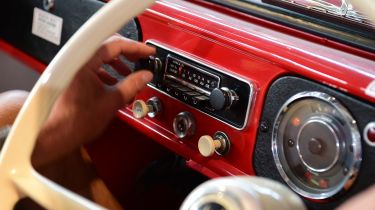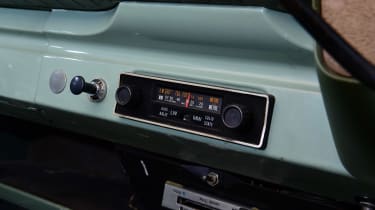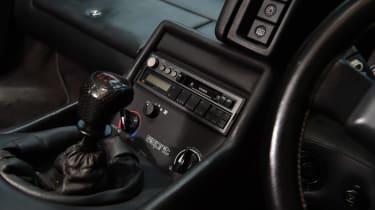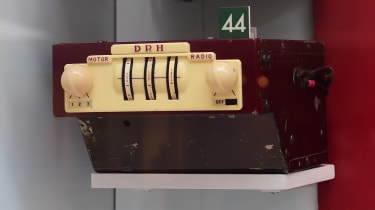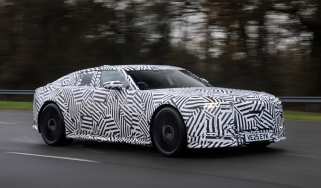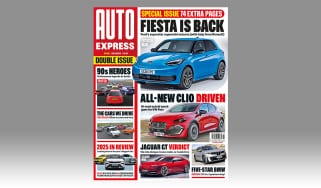History of car stereos: radios, records and cassettes to CDs and MP3s
In-car entertainment dated back 100 years in 2022. In that time there has been a bewildering array of technologies to deliver music on the move – but not all of them hit the right note
It was 1934 and a popular car of the day, the Hillman Minx, was unveiled in a new version called the Melody Minx. It differed from the standard Minx because it had a stylised harp as bonnet mascot. Why Melody? Why a harp? Because it was the first car to have a radio as standard.
The Philco Balanced Superhet Radio in the musical Minx was big, heavy and expensive – the Melody cost 25 per cent more than a standard Minx. As a difficult-to-tune crackly valve set, it was a world away from the hi-fidelity sound and automatic tuning that were to come.
Still, it was still a revelation for an increasingly car-mad country fresh out of the Roaring Twenties. There had been radios in cars before but making it a standard feature – and indeed naming the car for it – was entirely new. Early adopters included a young Hughie Green, who was photographed with the Melody Minx and the cast of the Entertainment Hour outside the BBC.
When other car makers, such as Crossley Motors, picked up on the idea of the factory-fit radio, there was no looking back, with music-on-the-move developing into today’s online streaming services via record players, 8-track cartridges, cassettes, mini-discs, CDs and plug-in MP3 players. All had their moment in the spotlight.
Through it all emerged a booming new industry devoted to ICE – in-car entertainment. The one constant in it all has been the wireless receiver, and in automotive terms that goes back to well before the Minx, to 1922.
How car radios began
Radio ‘hams’ experimented with home-built radios in cars in the very early years of the 20th century, but the first one offered by a car manufacturer and designed to work reliably was sold by Chevrolet in the US exactly a century ago.
With huge batteries under the seat, loudspeakers taking up the back seat and an aerial that covered the roof, it was impractical and cost thousands of pounds in today’s terms.
But the potential of it was not lost. The New York Radio Times reported: “With a car equipped in this fashion, it is possible for a family to drive anywhere within 100 miles or so of a broadcasting station and picnic while the radio in their car amuses or instructs them with music, sermons or wireless telegraphy.”
Being able to listen to a Sunday sermon while far from your local church was a selling point in America in the twenties. Other advantages of car radio were said to be entertaining the children on long journeys and helping keep the driver awake. Some things never change.
Others said a radio would distract the driver and cause accidents. Some US states proposed legislation to ban them. But that never happened and by the time a more compact set arrived that fitted into most cars of the day, the radio’s place in automotive history was sealed. The new radio was Galvin Manufacturing Corporation’s 5T71. It cost $130 (around £1,200 in today’s money) and was demonstrated as the world’s first commercially available car radio at the Radio Manufacturers Association convention in Atlantic City in 1930.
The company couldn’t afford to take a stand at the show, so company boss Paul Galvin parked his radio-equipped Studebaker outside and left it there with the windows open and the volume cranked up. Who knows, maybe it was here that Lord Rootes’ staff got the idea for the Melody Minx?
Paul Galvin got so many orders for the 5T71 he thought he’d better come up with a snappier name for his company. Motorola was born.
As car radios became more compact, more usable and cheaper, the full benefits of in-car listening became apparent. Traffic and weather reports and news joined the music. Later, live sports events made the airways. The late, great Sir Stirling Moss said he once listened to the radio commentary of the race he was in, while he was in it!
Car radios for everyone
The car companies loved ICE because it made their cars more appealing, and profitable, and radio stations loved it because they suddenly had a vast new listening audience.
Uptake was rapid; one estimate is that just 16 years after the first Motorola nine million cars around the world had radios in them. Despite efforts of cars like the Melody Minx, uptake in the UK was slower. For one thing, you needed a radio licence until 1971!
As Patrick Collins, research officer at the National Motor Museum in Beaulieu tells us, licence records provide a stark indication of how car radios took off in this country. In 1947, 24,000 car radio licences were issued; by 1969 the number was a million.
Advances that drove the growth included the first FM car radio (from Blaupunkt) in 1953, while the innovative Becker Mexico arrived a year later – it had a novel feature: it could automatically search for stations.
But the tipping point came in 1963 when Becker launched the Monte Carlo. It replaced vacuum tubes with transistors, making radios much smaller and less expensive. Other radio makers quickly changed to solid state and global sales hit 50 million.
And since then? Stereo arrived in 1969 with the Becker Europa; push-button presets made finding your favourite station easier, features proliferated, power outputs shot up and speakers went hi-tech and multiplied.
The top car brands also started offering premium systems that were built into the car at the design stage; the Bose system in Cadillacs from 1982 was the first. Today, all the big car names have a hi-fi partner, with something like the Mark Levinson audio system in the Lexus LS featuring 23 speakers and 2,400 watts of power.
Big-power ICE also found a ready home in the aftermarket, where a whole automotive sub-culture grew up around it. Upgrading your audio became a rite of passage for young drivers in the eighties and nineties. With a boot packed full of amplifiers and massive subwoofers, even a small car like the custom favourite Vauxhall Nova could become a mobile boom-box.
All this was not just to play what came out of the radio, of course. ‘Music on demand’ first arrived in the fifties in the unlikely form of the in-car record player. Chrysler offered the first in its top models in 1955. Called the Highway Hi-Fi, the firm promised that “It’s almost impossible to jar the arm off the record.” That wasn’t quite true.
The idea didn’t die though. Philips thought it had the skipping needle problem sorted with its Auto-Mignon ‘floating’ record player. In the sixties, no rock ’n’ roll god’s Rolls-Royce or Bentley was complete without an Auto-Mignon, most famously John Lennon’s Phantom.
The 8-track cartridge arrived in 1965. With four channels of stereo tracks pre-recorded on an endless loop of magnetic tape inside a sturdy plastic case, it promised unheard-of in-car user-friendliness. In theory.
Today few have good memories of the 8-track. It quickly became obsolete at the hands of something far superior in all ways: the compact cassette, which was rapidly adopted by motorists, making 8-track players redundant overnight – until the electronics industry came up with a cassette-to-8-track conversion device.
The compact cassette would go on to be incorporated into tens of millions of cars until the 2000s. Musical eras were defined for entire generations who grew up listening to music in their cars on cassettes, often the mix-tapes they had created themselves.
But there is always something new around the corner, and the cassette’s nemesis was the compact disc. The first one of these, the Pioneer CDX-1, arrived in 1984. A year later Mercedes became the first manufacturer to offer factory-installed in-dash CD players.
But not even the CD could outlast what came next: a shift first to digital music sources like MP3 players, satellite radio, and now online streaming through apps in Apple CarPlay or Android Auto. All you need in your car today to listen to virtually all the music ever recorded is your mobile phone.
The radio to have in 1952
Among the most impressive of early radios was the Trimatic from DRH, a division of GM. With its streamlined look and simple rotating tuning dials, it was very modern for 1952. Companies that factory-fitted the 18-guinea (plus purchase tax) radio in their cars included Crossley Motors.
Today the influential DRH Trimatic has another claim to fame: it is one of the items chosen by the National Motor Museum in Beaulieu for The Story of Motoring in 50 Objects exhibition.
The 50 items, from a Rolls-Royce Ghost to a crash test dummy and an England football supporter’s car accessory pack from 2013, have been assembled to mark 50 years since the museum opened.
Edward, Lord Montagu first displayed five cars in the entrance to Palace Hall as a tribute to his motoring pioneer father John 2nd Baron Montagu. The display grew into a museum which was opened by HRH The Duke of Kent in July 1972. It was the first permanent national motor museum in the world.
Today, with Edward’s son Ralph the current Lord Montagu at the helm, the National Motor Museum has more than 1.7 million items in its collection, all cared for by the National Motor Museum Trust.
It is from this vast resource that museum curators whittled down the 50 most historically important vehicles, motoring artefacts, images, films and documents – and radios, of course.
The Story of Motoring in 50 Objects exhibition remains open until April 2023.
Timeline
- 1922 - Chevrolet is the first manufacturer to offer a car radio.
- 1934 - Melody Minx launched.
- 1947 - 24,000 radio licences.
- 1953 - First FM car radio.
- 1955 - Chrysler offered music on demand.
- 1960s - ‘Floating’ record player on Rolls-Royce (John Lennon’s Phantom) and Bentley.
- 1963 - Vacuum tubes were replaced with transistors, making radios smaller and cheaper.
- 1965 - 8-track cartridge introduced.
- 1969 - Stereo arrived. One million radio licences.
- 1982 - Bose stereos in Cadillacs.
- 1985 - In-dash CD players, first introduced by Mercedes.
- 2022 - Apple CarPlay and Android Auto now virtually standard.
Click here to read about the future of electric car sounds...
Find a car with the experts
